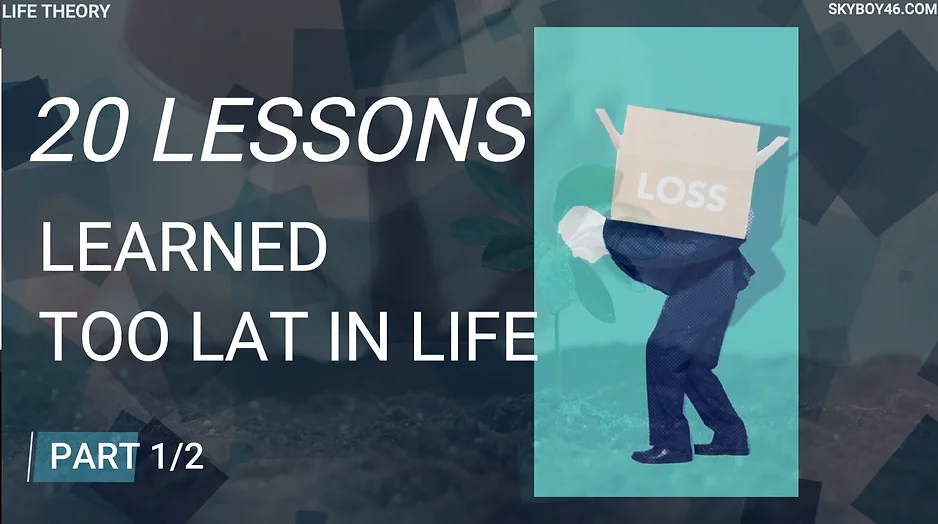Don’t Want To Read?
Watch/Listen To The Full Video on YouTube
Worrying is a natural part of life, but it doesn’t have to control us. When we overthink, we drain our energy and focus, leaving us feeling exhausted and overwhelmed. The solution? Action. Even small steps can break the cycle of worry and clear the mental fog. Instead of spiraling into anxiety, ask yourself: what can I do now to reduce this stress? By taking action—whether it’s as simple as sending a message or setting a plan—you regain control. Externalizing your worries or practicing calming strategies like taking breaks, moving your body, or connecting with others can also help. Remember, you can’t predict everything, but you can control how you respond.
SUBSCRIBE: https://www.youtube.com/@LifeTheory46
Banish the Overthinking Trap – Life Stories 185
We’ve got a question for you: Did you catch yourself worrying today? Just for a second, bring that moment to the forefront of your mind. Hold onto a single image that represents this worry. Now, picture that thought being gently taken from your mind and locked in a small box until you’re ready to come back to it.
Here’s the thing—worrying is a part of life. It’s our brain’s way of preparing us for what could happen, almost like running a mental simulation of every possible outcome. But in today’s world, there’s an overwhelming number of things to stress about—pandemics, wars, everyday responsibilities. Our brains crave certainty, yet we live in a time where unpredictability is the new normal. This creates a dissonance between what our brains need and what reality offers, leading to an endless cycle of anxiety.
So if worrying is a natural response, why is it crucial that we learn to worry less? Because, as you already know, too much of it drains our mental energy and shatters our focus. It doesn’t just tire us out—it completely exhausts us. Imagine trying to fight a battle where you’ve got no armor, no map, and no clear target. You’re left swinging at thin air, using up all your resources without ever getting anywhere. That’s exactly what excessive worrying feels like.
When we worry, our bodies flood with cortisol, making us feel on edge, restless, and perpetually drained. That heightened state impacts our decision-making and often leads us to make impulsive choices. It’s a vicious cycle. But here’s the kicker: you can’t predict every twist and turn in life. Trying to map out every potential outcome is not just impossible—it’s damaging.
So what’s the alternative?
The answer is action. It doesn’t have to be some grand gesture or earth-shattering move. It can be as small as asking a question, clarifying a point, or taking a tiny step forward. Why? Because the antidote to worry isn’t some magic cure—it’s breaking the paralysis with deliberate movement, no matter how small. Every step, every action, chips away at the mental fog that worry creates.
Take a minute right now and think of one thing that’s been causing you anxiety. Bring it out of that mental box and identify it. Now, answer these questions: What do I need in order to feel less anxious? What’s one action I can take to get to that place? Is it asking for help, looking up some information, or just taking a break from thinking about it? Whatever it is, write it down. Feel the energy that comes from focusing on a specific solution instead of drowning in the chaos of uncertainty.
And look, if you can act on it right now, go ahead. Even if it’s just sending a quick text, making a decision, or jotting down a plan—do it. If not, that’s okay too. Set it aside and let your subconscious work its magic. The subconscious is like a powerful processing unit, capable of untangling thoughts and bringing clarity when we step back. Just remember to revisit it after some time. Let your mind rest, sleep on it, and approach it fresh.
Here’s the rule of thumb: If you can act, act. If you can’t, decide to stop worrying.
I know, I know—it’s easier said than done. But that’s why there are additional strategies to help calm those swirling thoughts. One effective approach is to externalize your worries. Think of your anxiety as a character—let’s call her “Worried Wanda.” Picture Wanda coming to you, trying to warn you about every little thing that could go wrong. Instead of getting overwhelmed, engage with her. Ask her what she needs from you, tell her you’ll handle it, and kindly show her the door. Or maybe try negotiating—“Hey, Wanda, thanks for the warning, but I’ve got this. I’ll think about it tomorrow.” By creating a bit of distance, you make it easier to manage the spiral.
If that seems too abstract, try one of these three tips to regain your calm:
- Take regular breaks. Simple, right? But it’s effective. Stepping away from the situation gives your brain a chance to reset.
- Move your body. Whether it’s a quick stretch, a stroll around the block, or a more intense workout, moving helps clear out the cortisol and refreshes your mind.
- Connect with someone. Talk it out with a friend or family member. Sometimes just saying it aloud is enough to shrink the worry down to size.
It’s okay to worry. But it’s not okay to let worry run your life. So, what are you going to try next time anxiety rears its head? Which strategy will you experiment with? Because you deserve to move through life without the weight of constant unease.
Remember, while you may not be able to predict or control everything, you can always control how you respond. Worry less, act more. It’s time to break free and focus on what truly matters. Go out there and crush it!
–> Read More Life Stories Here:
https://www.lifetheory.us
https://www.lifetheory.eu
Buy all of our Life Stories & Our Premium Learning Packs. Listen or Read to them anytime you want. Have them Forever.
You can get each monthly lesson on our website at https://www.skyboy46.com/store
SHARE THIS STORY
Visit Our Store
SHOP NOW
www.skyboy46.com & www.myskypet.com
Designed For Pet Lovers & Introverted Souls
Sport, Hobbies, Motivation, Music & Art






~EXPLORE MORE~
www.linktr.ee/skyboy46


